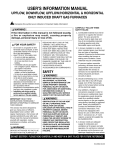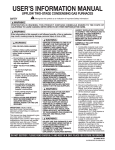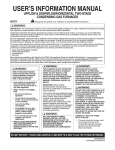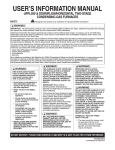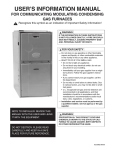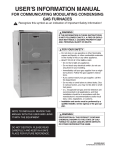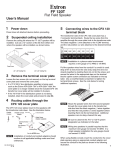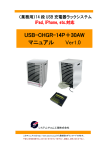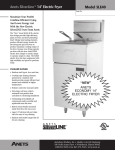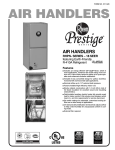Download Rheem X-13 Use & Care Manual
Transcript
USER’S INFORMATION MANUAL UPFLOW, DOWNFLOW, UPFLOW/HORIZONTAL & HORIZONTAL ONLY INDUCED DRAFT GAS FURNACES ! Recognize this symbol as an indication of Important Safety Information! WARNING If the information in this manual is not followed exactly, a fire or explosion may result, causing property damage, personal injury or loss of life. ! ! FOR YOUR SAFETY — Do not store or use gasoline or other flammable vapors and liquids, or other combustible materials in the vicinity of this or any other appliance. — WHAT TO DO IF YOU SMELL GAS • Do not try to light any appliance. • Do not touch any electrical switch; do not use any phone in your building. • Immediately call your gas supplier from a neighbor’s phone. Follow the gas supplier’s instructions. • If you cannot reach your gas supplier, call the fire department. • Do not rely on smell alone to detect leaks. Due to various factors, you may not be able to smell fuel gases. • A U. L. recognized fuel gas and CO detector(s) are recommended in all applications, and their installation should be in accordance with the manufacturer’s recommendations and/or local laws, rules, regulations or codes. — Installation and service must be performed by a qualified installer, service agency or the gas supplier. IMPORTANT: READ THESE INSTRUCTIONS THOROUGHLY BEFORE ATTEMPTING TO OPERATE THIS FURNACE. This furnace has been designed to give you many years of efficient, dependable home comfort. With regular maintenance, this furnace will operate satisfactorily year after year. Please read this manual to familiarize yourself with operation, routine maintenance schedule, and safety procedures. ! WARNING DEVICES ATTACHED TO THE FLUE OR VENT FOR THE PURPOSE OF REDUCING HEAT LOSS UP THE CHIMNEY, INCLUDING FIELDINSTALLED DRAFT INDUCERS, HAVE NOT BEEN TESTED AND HAVE NOT BEEN INCLUDED IN THE DESIGN CERTIFICATION OF THIS FURNACE. WE, THE MANUFACTURER, CANNOT AND WILL NOT BE RESPONSIBLE FOR INJURY OR DAMAGE CAUSED BY THE USE OF SUCH UNTESTED AND/OR UNCERTIFIED DEVICES, ACCESSORIES OR COMPONENTS. SAFETY ! WARNING IMPROPER INSTALLATION, ADJUSTMENT, ALTERATION, SERVICE OR MAINTENANCE CAN CAUSE PROPERTY DAMAGE, PERSONAL INJURY OR DEATH. FOR ASSISTANCE OR ADDITIONAL INFORMATION CONSULT A QUALIFIED INSTALLER, SERVICE AGENCY OR THE GAS SUPPLIER. ! WARNING OBSTRUCTION OF THE AIR VENT ON AN LP (PROPANE) TANK REGULATOR CAN CAUSE EXPLOSION OR FIRE RESULTING IN PROPERTY DAMAGE, SEVERE PERSONAL INJURY OR DEATH. YOUR GAS SUPPLIER SHOULD PERIODICALLY INSPECT AND CLEAN THE AIR VENT SCREEN TO PREVENT ANY OBSTRUCTION. KEEP PROTECTIVE REGULATOR COVER IN PLACE, AS EXPOSURE TO THE ELEMENTS CAN CAUSE ICE BUILDUP AND REGULATOR FAILURE. CAREFULLY FOLLOW THESE SAFETY RULES: 1. Combustible material must not be placed on or against the furnace jacket. The area around the furnace must be kept clear and free of all combustible materials including gasoline and other flammable vapors and liquids. 2. A furnace installed in an attic or other insulated space must be kept free and clear of insulating material. Examine the furnace area when installing the furnace or adding more insulation. Some materials may be combustible. 3. To prevent carbon monoxide poisoning, all blower doors and compartment covers must be replaced after the furnace is serviced. Do not operate the unit without all panels and doors securely in place. 4. Should overheating occur, or the gas valve fail to shut off the gas supply, turn off the manual gas valve to the furnace before turning off the electrical supply. 5. Any additions, changes or conversions required in order for the furnace to satisfactorily meet the application needs should be made by a qualified installer, service agency or the gas supplier, using factory specified or approved parts. Read your WARRANTY. Contact the WARRANTOR for conversion information. This furnace was equipped at the factory for use on NATURAL GAS ONLY. Conversion to L.P. GAS requires a special kit supplied by the WARRANTOR. 6. A furnace needs an adequate supply of combustion and ventilation air for proper and safe operation. Do not block or obstruct air openings on the furnace or air openings supplying the area where the furnace is installed. Do not store anything around the furnace that could block the flow of fresh air to the unit. Your installation may DO NOT DESTROY. PLEASE READ CAREFULLY AND KEEP IN A SAFE PLACE FOR FUTURE REFERENCE. 92-20802-114-00 receive air from the inside heated space., from the outside, from the attic or crawl space. Whenever adding insulation, be sure the air supply openings are not covered. 7. Do not use this furnace if any part has been under water. Immediately call a qualified installer, service agency or the gas supplier to inspect the furnace and to replace any part of the control system and any gas control which has been under water. GENERAL INFORMATION ! WARNING DUCT LEAKS CAN CREATE AN UNBALANCED SYSTEM AND DRAW POLLUTANTS SUCH AS DIRT, DUST, FUMES AND ODORS INTO THE HOME CAUSING PROPERTY DAMAGE. FUMES AND ODORS FROM TOXIC, VOLATILE OR FLAMMABLE CHEMICALS, AS WELL AS AUTOMOBILE EXHAUST AND CARBON MONOXIDE (CO), CAN BE DRAWN INTO THE LIVING SPACE THROUGH LEAKING DUCTS AND UNBALANCED DUCT SYSTEMS CAUSING PERSONAL INJURY OR DEATH (SEE FIGURE 1). • IF AIR-MOVING EQUIPMENT OR DUCTWORK IS LOCATED IN GARAGES OR OFF-GARAGE STORAGE AREAS - ALL JOINTS, SEAMS, AND OPENINGS IN THE EQUIPMENT AND DUCT MUST BE SEALED TO LIMIT THE MIGRATION OF TOXIC FUMES AND ODORS INCLUDING CARBON MONOXIDE FROM MIGRATING INTO THE LIVING SPACE. • IF AIR-MOVING EQUIPMENT OR DUCTWORK IS LOCATED IN SPACES CONTAINING FUEL BURNING APPLIANCES SUCH AS WATER HEATERS OR BOILERS ALL JOINTS, SEAMS, AND OPENINGS IN THE EQUIPMENT AND DUCT MUST ALSO BE SEALED TO PREVENT DEPRESSURIZATION OF THE SPACE AND POSSIBLE MIGRATION OF COMBUSTION BYPRODUCTS INCLUDING CARBON MONOXIDE INTO THE LIVING SPACE. ! NOTICE IMPROPER INSTALLATION, OR INSTALLATION NOT MADE IN ACCORDANCE WITH THE CSA INTERNATIONAL (CSA) CERTIFICATION OR THESE INSTRUCTIONS, CAN RESULT IN UNSATISFACTORY OPERATION AND/OR DANGEROUS CONDI-TIONS AND ARE NOT COVERED BY THE UNIT WARRANTY. ! NOTICE IN COMPLIANCE WITH RECOGNIZED CODES, IT IS RECOMMENDED THAT AN AUXILIARY DRAIN PAN BE INSTALLED UNDER ALL EVAPORATOR COILS OR UNITS CONTAINING EVAPORATOR COILS THAT ARE LOCATED IN ANY AREA OF A STRUCTURE WHERE DAMAGE 2 TO THE BUILDING OR BUILDING CONTENTS MAY OCCUR AS A RESULT OF AN OVERFLOW OF THE COIL DRAIN PAN OR A STOPPAGE IN THE PRIMARY CONDENSATE DRAIN PIPING. SEE ACCESSORIES SECTION OF THESE INSTRUCTIONS FOR AUXILIARY HORIZONTAL OVERFLOW PAN INFORMATION (MODEL RXBM). IMPORTANT INFORMATION ABOUT EFFICIENCY AND INDOOR AIR QUALITY Central cooling and heating equipment is only as efficient as the duct system that carries the cooled or heated air. To maintain efficiency, comfort and good indoor air quality, it is important to have the proper balance between the air being supplied to each room and the air returning to the cooling and heating equipment. Proper balance and sealing of the duct system improves the efficiency of the heating and air conditioning system and improves the indoor air quality of the home by reducing the amount of airborne pollutants that enter homes from spaces where the ductwork and / or equipment is located. The manufacturer and the U.S. Environmental Protection Agency’s Energy Star Program recommend that central duct systems be checked by a qualified contractor for proper balance and sealing. RECEIVING Immediately upon receipt, all cartons and contents should be inspected for transit damage. Units with damaged cartons should be opened immediately. If damage is found, it should be noted on the delivery papers, and a damage claim filed with the last carrier. • After unit has been delivered to job site, remove carton taking care not to damage unit. • Check the unit rating plate for unit size, electric heat, coil, voltage, phase, etc. to be sure equipment matches what is required for the job specification. • Read the entire instructions before starting the installation. • Some building codes require extra cabinet insulation and gasketing when unit is installed in attic applications. • If installed in an unconditioned space, apply caulking around the power wires, control wires, refrigerant tubing and condensate line where they enter the cabinet. Seal the power wires on the inside where they exit conduit opening. Caulking is required to prevent air leakage into and condensate from forming inside the unit, control box, and on electrical controls. • Install the unit in such a way as to allow necessary access to the coil/filter rack and blower/control compartment. FIGURE 1 MIGRATION OF DANGEROUS SUBSTANCES, FUMES, AND ODORS INTO LIVING SPACES • Install the unit in a level position to ensure proper condensate drainage. Make sure unit is level in both directions within 1/8”. • Install the unit in accordance with any local code which may apply and the national codes. Latest editions are available from: “National Fire Protection Association, Inc., Batterymarch Park, Quincy, MA 02269.” These publications are: • ANSI/NFPA No. 70-(Latest Edition) National Electrical Code. • NFPA90A Installation of Air Conditioning and Ventilating Systems. • NFPA90B Installation of warm air heating and air conditioning systems. • The equipment has been evaluated in accordance with the Code of Federal Regulations, Chapter XX, Part 3280. SYSTEM OPERATION INFORMATION 1. Keep the air filters clean. Your heating system will operate more efficiently and provide better heating, more economically. Figure 2. Burner Compartment, showing location of Gas Controls 2. Arrange your furniture and drapes so that the supply air registers and the return air grilles are unobstructed. 3. Close doors and windows. This will reduce the heating load on your system. 4. Avoid excessive use of kitchen exhaust fans. 5. Do not permit the heat generated by television, lamps, or radios to influence the thermostat operation. 6. If you desire to operate your system with constant air circulation, please ask advice from a qualified installer, service agency or the gas supplier. During the heating season the operation of the warm air furnace is automatic. Your qualified installer, service agency or the gas supplier has provided a wall mounted thermostat which is sensitive to the change in temperature of the air moving around the thermostat. Your thermostat will have switches to select some or all of the following functions: IF YOU DO NOT FOLLOW THESE INSTRUCTIONS EXACTLY, A FIRE OR EXPLOSION MAY RESULT CAUSING PROPERTY DAMAGE, PERSONAL INJURY OR LOSS OF LIFE. HEAT - Turns heating on when temperature drops below the desired temperature. NOTE: Read and follow the Safety Information, Operating Instructions and Instructions To Turn Off Gas To Appliance located on the furnace. This label will have specific information regarding the furnace and its gas controls. COOL - Turns cooling on when temperature rises above the desired temperature. AUTO - Turns cooling or heating on as required to maintain the desired temperature. OFF - Turns heating and cooling modes off. (The blower may still run in the FAN-ON position.) FAN-ON - Turns the blower on for continuous operation. FAN-AUTO - The blower cycles on and off with cooling or heating operation. FOR YOUR SAFETY READ BEFORE OPERATING ! WARNING TYPICAL GAS CONTROL VALVE A. Gas valves and controls vary in appearance, but two basic types are standard. ELECTRIC IGNITION The gas control lever or knob has “ON” and “OFF” positions only (see Figure 3). This furnace is equipped with an ignition device which automatically lights the burners. Do not try to light the burners by hand. B. BEFORE OPERATING smell all around the appliance area for gas. Be sure to smell next to the floor because some gas is heavier than air and will settle on the floor. WHAT TO DO IF YOU SMELL GAS • Do not try to light any appliance • Do not touch any electric switch; do not use any phone in your building. • Immediately call your gas supplier from a neighbor’s phone. Follow the gas supplier’s instructions. • If you cannot reach your gas supplier, call the fire department. 3 TO TURN OFF GAS TO THE APPLIANCE 1. Set the thermostat to the lowest setting. 8. Turn on the gas to the main burners by moving the gas control lever (switch) from the “OFF” to the “ON” position. 9. Replace the control door. 2. Turn off all electric power to the appliance if service is to be performed. 10. Turn on all electric power to the appliance. 3. Remove the control door. 11. Set the thermostat to the desired setting. 4. Turn the gas control knob or switch to the “OFF” position, or depress the gas control lever and move to the “OFF” position. 5. Replace control door. OPERATING INSTRUCTIONS (DIRECT IGNITION SYSTEM) 1. STOP! Read all safety information. Figure 3. Gas Valve On/Off Switch ON/OFF SWITCH 12. If the appliance will not operate, follow the instructions “To Turn Off Gas To The Appliance” and call your qualified installer, service agency or the gas supplier. TO TURN OFF GAS TO THE APPLIANCE 1. Set the thermostat to the lowest setting. 2. Turn off all electric power to the appliance if service is to be performed. 3. Remove the control door. 4. Turn the gas control knob or set the gas control switch to the “OFF” position, or depress the gas control lever and move to the “OFF” position. 5. Replace the control door. WHITE-RODGERS VALVE ON/OFF SWITCH HONEYWELL VALVE 2. Set the thermostat to the lowest setting. 3. Turn off all electric power to the appliance. 4. This appliance does not have a pilot burner. It is equipped with an ignition device which automatically lights the burner. Do not try to light the burner by hand. 5. Remove control door. 6. Set the gas control switch to the “OFF” position. 7. Wait five (5) minutes to clear out any gas. If you then smell gas, STOP! Follow ‘B’ in the safety information above. If you don’t smell gas, go to the next step. 4 FLAME ROLL-OUT SAFETY SWITCHES This furnace is equipped with limit switches to protect against overtemperature conditions in the control compartment caused by inadequate combustion air supply. The switch is located just above the burners on the blower divider panel. Switches for the UPFLOW HORIZONTAL are located on both sides of the burner brackets and just above the burners on the blower divider panel. If a switch is tripped it must be manually reset. DO NOT jumper this switch. If this switch should trip, a qualified installer, service agency or the gas supplier should be called to check and/or correct for adequate combustion air supply. MAINTENANCE ! WARNING DISCONNECT MAIN ELECTRICAL POWER TO THE UNIT BEFORE ATTEMPTING ANY MAINTENANCE. FAILURE TO DO SO CAN CAUSE ELECTRICAL SHOCK RESULTING IN SEVERE PERSONAL INJURY OR DEATH. ! CAUTION DO NOT OPERATE YOUR SYSTEM FOR EXTENDED PERIODS WITHOUT FILTERS. A PORTION OF THE DUST ENTRAINED IN THE AIR MAY TEMPORARILY LODGE IN THE AIR DUCT RUNS AND AT THE SUPPLY REGISTERS. ANY RECIRCULATED DUST PARTICLES WILL BE HEATED AND CHARRED BY CONTACT WITH THE FURNACE HEAT EXCHANGER. THIS RESIDUE WILL SOIL CEILINGS, WALLS, DRAPES, CARPETS, AND OTHER HOUSEHOLD ARTICLES. IT IS RECOMMENDED THAT AN ANNUAL INSPECTION OF YOUR FURNACE BE DONE BY A QUALIFIED INSTALLER, SERVICE AGENCY OR THE GAS SUPPLIER. FILTER MAINTENANCE Have your qualified installer, service agency or the gas supplier instruct you on how to access your filters for regular maintenance. ! WARNING TURN OFF ELECTRICAL POWER TO FURNACE BEFORE REMOVING FRONT ACCESS DOOR. FAILURE TO DO SO CAN RESULT IN ELECTRICAL SHOCK, SEVERE PERSONAL INJURY OR DEATH. Keep air filters clean at all times. Vacuum dirt from filter, wash with detergent and water, air dry thoroughly and reinstall. After filters are cleaned and returned to the furnace, be sure doors are properly reinstalled. If you are not totally sure of this procedure, consult a qualified installer, service agency or the gas supplier. REMOVING FILTERS UPFLOW FURNACE - FILTER IN BOTTOM LOCATION 1. Remove the blower compartment access door. 2. Disengage the filter retaining rod and pull filter out. 3. Clean filter and reinstall. DOWNFLOW FURNACE - FILTERS IN TOP DUCT LOCATION 1. Remove the blower compartment access door. 2. Push up and in on the filters to disengage from retaining bracket and pull filters out. 3. Clean filter(s) and reinstall. Figure 4. Upflow Filter Location Figure 5. Upflow Side Filter Installation UPFLOW FILTER SIZES FURNACE WIDTH 14ⴖ 171⁄2ⴖ 21ⴖ 241⁄2ⴖ INPUT BTUH (K’s) 45 & 50 67, 75 & 100 100 125 & 150 SIZE BOTTOM SIDE 121⁄4ⴖ x 25ⴖ 153⁄4ⴖ x 25ⴖ 153⁄4ⴖ x 25ⴖ 153⁄4ⴖ x 25ⴖ 191⁄4ⴖ x 25ⴖ 153⁄4ⴖ x 25ⴖ 223⁄4ⴖ x 25ⴖ 153⁄4ⴖ x 25ⴖ QTY. 1 1 1 1 Figure 6. Downflow Filters Installation DOWNFLOW FILTER SIZES FURNACE WIDTH 14ⴖ 171⁄2ⴖ 21ⴖ 241⁄2ⴖ INPUT BTUH (K) 45 & 50 67, 75 & 100 100 125 & 150 SIZE QTY. 14ⴖ x 20ⴖ 12ⴖ x 20ⴖ 12ⴖ x 20ⴖ 14ⴖ x 20ⴖ 1 2 2 2 5 ROUTINE MAINTENANCE Routine maintenance to be provided by a qualified installer, service agency or the gas supplier ONLY. LUBRICATION The blower motor and induced draft motor are prelubricated by the manufacturer and do not require further attention. ! WARNING DISCONNECT MAIN ELECTRICAL POWER TO THE UNIT BEFORE ATTEMPTING ANY MAINTENANCE. FAILURE TO DO SO CAN RESULT IN ELECTRICAL SHOCK, SEVERE PERSONAL INJURY OR DEATH. The blower compartment and motor should be inspected and cleaned periodically by your qualified installer, service agency or the gas supplier to prevent the possibility of overheating due to an accumulation of dust and dirt on the windings or on the motor exterior. And, as suggested elsewhere in these instructions, the air filters should be kept clean because dirty filters can restrict airflow and the motor depends upon sufficient air flowing across and through it to keep from overheating 6 COMBUSTION AREA AND VENT SYSTEM 1. It is recommended that an annual inspection of your furnace be done by a qualified installer, service agency or the gas supplier. 2. Turn OFF the electrical supply to the furnace and remove the access doors. 3. Inspect the gas burners for dirt, rust, or scale. ! WARNING IF DIRT, RUST, SOOT OR SCALE ACCUMULATIONS ARE PRESENT, DO NOT OPERATE THE FURNACE. INSPECT THE HEAT EXCHANGERS FOR LEAKS. LEAKS CAN CAUSE TOXIC FUMES TO ENTER THE HOME RESULTING IN CARBON MONOXIDE POISONING OR DEATH. 4. Inspect the the flue connection area and vent pipe. Be sure that the vent connector is in place and slopes upward and is physically sound, without holes or excessive corrosion. ! WARNING IF HOLES ARE FOUND IN THE VENT PIPE, OR IF IT HAS BECOME DISCONNECTED, TOXIC FUMES CAN ESCAPE INTO THE HOME RESULTING IN CARBON MONOXIDE POISONING OR DEATH. DO NOT OPERATE THIS FURNACE. APPROPRIATE SERVICE MUST BE APPLIED. 5. Be sure that the return air duct connections are physically sound, are sealed to the furnace casing and terminate outside the space containing the furnace. 6. Be sure the physical support of the furnace is sound, without sags, cracks, etc., around the base so as to provide a seal between the support and the base. 7. Look for obvious signs of deterioration of the furnace. 8. If the furnace is free of the above conditions, replace the access doors and restore electrical power to the furnace. 9. Start the furnace and observe its operation. Watch the burner flames to see if they are bright blue. If a suspected malfunction is observed, or the burner flames are not bright blue, apply appropriate service. 7 8 CM 0310










